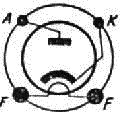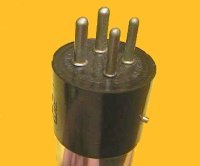
KR1
|
|
|||||||||||||||||||||||||||||||||||||||||||
|
Hits: 3642 Replies: 2
KR1 (KR1)
|
|
|
Konrad Birkner † 12.08.2014
29.Jun.11 |
1
While there is contradictory information found in secondary literature, and evidence by primary (manufacturer's) paper is still missing, at least the photo shows traces of metal deposits inside the glass envelope. That could indicate mercury. |
|
Emilio Ciardiello
29.Jun.11 |
2
Dear Konrad, in 'Tube Lore' Sybley gives this Ken-Rad tube as single-diode mercury rectifier, 350V, 50mA. According to the same source, this rectifier was superseded by the type 1-V. I just added these info in the tube data. Regards, Emilio |
|
Konrad Birkner † 12.08.2014
02.Jul.11 |
3
To shed some light into the matter I asked Ludwell Sibley of the Tube Collectors Association TCA, author of Tube Lore, the following questions: ------------------------------------------- The 1-V is called the successor of the KR-1. As far as I can find data (e.g. in Babani) both have the same filament data (6.3 V / 0.3 A), the same max plate voltage (350 V) and current (50 mA). But Babani calls both being high vacuum types, while the KR-1 is obviously an MVR. (well, nobody is perfect..). My problem is: I can't find voltage drop figures. For a mercury arc it should be considerably lower (<15 V) than for a high vacuum type (>20 V). Did such a replacement affect a set's performance e.g. by slightly lower +B? And how about current overload? According to GE Essential characteristics the 1-V has a drop of 20 mV at 90 mA, while the max dc output current is given with 45 mA.
All that does not match.
He kindly replied as follows: The KR-1 is widely accepted as being a mercury device, having come out in a wave of mercury consumer-radio tubes (the 280M, 288M, 82, 83, and so on). It was exclusively a Ken-Rad product. However, RCA announced, ca. 1932, its Type 1 – an equivalent mercury device. (This, per an announcement in “Radio Engineering” or a similar technical magazine. I’ve read it, but didn’t take notes at the time.) Collectors have found a (very) few samples – the massive Dowd Collection has two, plus two 1-vs. The Jones Collection does not apparently have a 1, but has a 1-v. Now, the commercial life of RCA’s Type 1 was only about a month! They i-m-m-e-d-i-a-t-e-l-y announced the 1-v vacuum version. I suspect that someone realized that a mercury-vapor tube in an automobile, under summer heat and winter cold, was not such a good idea. The bigger mercury rectifiers (866 and up) were certainly fussy about the condensed-mercury temperature. RCA’s RC-13 manual of 1937 claims the 1 and 1-v are interchangeable in practice even though, in terms of absolute voltage drop, they can’t literally be. It gives the same ratings (350 V in, 50 mA out) as Babani. I once tried locate other users of the KR-series tubes and was disappointed. I suppose that plugging a 1-v into a Kadette would slightly decrease the power output, but not enough to be noticeable. Commercially, the 1-v is indeed the successor to the KR1, both in terms of what the harried radio repairman would use and what the interested radio designer would select. The KR1 was from an obscure specialty manufacturer with limited distribution, whereas the 1-v was available from “everybody” – RCA, Sylvania, GE, and Tung-Sol. It was rather successful in 300-mA AC-DC radios until the 25Z5 came along, although it doesn’t seem to have appeared much (or at all) in car sets. I have a pair of 1-vs branded “General Electric.” Their construction is slightly different (one, from the “etch” marking, looks like RCA production). However, neither is of any special construction for low voltage drop, like one version of the 84 / 6Z4 with a special space-charge-offsetting grid. They are close-spaced, cathode to plate, but that’s all. I hope this provides some insight! Best,
Ludwell Sibley |
End of forum contributions about this tube
| Data Compliance | More Information |



